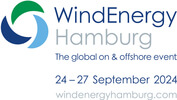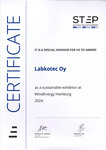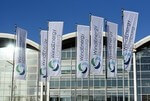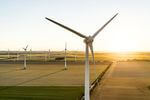News Release from Hamburg Messe und Congress GmbH
Wind Industry Profile of
Floating wind at WindEnergy Hamburg: From demonstration projects to industrial scale
The current global installed base is still small, with around 22 operational turbines (~0.15 GW), including three demonstration projects with 2x3 and 1x5 turbines, respectively. NV anticipates that the world’s floating wind capacity could reach a cumulative installed capacity of almost 2GW by 2025 through ongoing technology development and market expansion. They predict a rise to 15 % of total offshore wind generation by 2050 with a 264 GW total capacity installed by that year.
Challenges
The international classification society and WindEnergy Hamburg exhibitor DNV adds that floating wind increases flexibility in site selection, including target areas with higher wind speeds and/or lower social and environmental impact. DNV says that currently over 40 floating concepts are under development, with new designs announced regularly. Several build on comparable, wellestablished design principles, while others ‘challenge factors such as mass and fabrication approach’.
Henrik Bredmose is a professor and floating wind expert heading the section Response, Aeroelasticity, Control, and Hydrodynamics at Denmark’s Technical University (DTU). It conducts dedicated fundamental and applied research and supports several floating wind developments including X1 Wind and TetraSpar. He is confident that the technologies will mature soon and that the levelised cost of electricity (LCOE) will come down, the WindEnergy Hamburg exhibitor wrote late last year in the publication ‘DTU International Energy Report 2021: Perspectives on Wind Energy’. The report reflects LCOE reduction trends for floating wind. Recent levels were around 180€/MWh, falling further to this year’s estimated 110-120€/MWh, and predicting a level of 60€/MWh by 2030. The latter value is comparable to the current LCOE for bottom-fixed offshore wind of roughly 50€/MWh.
Rapid industrialisation
Bredmose is further convinced that rapid full supply chain industrialisation will be key to market success, from floater development to manufacture, optimisation and transport, and through to assembly and installation. Assuming an average commercial wind farm size of 50-100 units at some time in future, completing one 100-turbine project annually would require two floaters to leave the fabrication and assembly facilities every week.
Another trend Bredmose highlights is the fact that floater projects tend to use mature, three-bladed turbines in the upper 8-10 MW range now and are likely to advance to even bigger units soon, in line with the development in the mainstream bottom-fixed segment. Mature turbine and floater combinations are thereby instrumental in creating the necessary market pull and the required scaling of volumes. This should ideally go in parallel with learning from projects involving alternative solutions, including radically disruptive designs, plus a willingness of investors to accept the associated risks and costs, says Bredmose, concluding:
“This is an age of offshore wind revolution. Ambitious governmental targets put constant demand on bottom-fixed and floating wind technology development. DTU contributes to this development through science, insight, methods and tools. We work with companies and research institutions from around the world and the WindEnergy Hamburg event is the perfect place to generate new collaborations and strengthen existing ones.”
Currently most floating wind turbines operate in European waters. WindEnergy Hamburg exhibitors Siemens Gamesa and Vestas are the dominant suppliers of three-bladed upwind turbines for projects outside China and Japan. Most projects use either spar-type (Hywind) or semi-submersible floating platforms.
The world’s biggest floating windfarm to date, the Hywind Tampen project being built by the energy company Equinor in Norway, features eleven 8.6 MW Siemens Gamesa turbines atop concrete spar-type floaters.
First tension-leg floating platform announced
A first three-turbine, 24 MW demonstration project in France using SBM Offshore’s tension-leg floater platform (TLP) is anticipated for 2023. The TetraSpar Demonstrator project off the Norwegian coast is pioneering this technology. Among the project partners is the German utility company RWE Renewables, which will be represented at WindEnergy Hamburg. The TetraSpar project is being described as ‘the world’s first full-scale demonstration of an industrialized offshore floating foundation’. TetraSpar is a tetrahedral frame structure consisting of factory-produced elements that eliminates traditional assembly by welding.
An unusual element is a retractable keel that offers spar-type floater stability without requiring deep water during system assembly. The demonstrator, fitted with a 3.6 MW direct-drive Siemens Gamesa turbine, was installed off the Norwegian coast in 200-metre deep water in July 2021. The lead technology development partner claims a reduction in manufacturing hours by 85-90% compared to a conventionally produced equivalent.
Further radical innovations include solutions with downwind operation, two blades instead of three, and/or two or more rotors atop a single floater. The company X1 Wind for instance is working on its first commercial-scale product, the EU-funded X1 ACCELERATOR project involving the ‘disruptive’ X90 platform for a downwind turbine in the 5-6 MW range, possibly fitted with a two-bladed unit.
Nezzy2, an entirely new concept
The German utility company Energie Baden-Württemberg AG (EnBW) plans to build and operate floating wind farms offshore various European countries. France is described as the ideal entry market because EnBW has a local subsidiary, VALECO. In 2019 EnBW itself acquired an exclusive license for the radical twin-rotor floating concept Nezzy² for Europe, the USA and Taiwan. After successful tests of a 1:10 scale demonstrator in German waters in 2020, testing and validation of a full-scale, roughly 363-metre wide 16.6 MW demonstrator in China is expected to begin in late 2022 or early 2023.
"WindEnergy Hamburg is the world’s largest wind fair and therefore a special event for EnBW in providing us the opportunity for exchanging ideas with potential partners, suppliers and manufacturers across wind industry sectors. A main ongoing task is finding suitable Nezzy² suppliers for either components or, ideally, to serve as EPCI contractor for full-floater structures.
EnBW further aims at a second 1:1 demonstrator in European waters through cooperation with an EPCI-contractor project partner. Our presence in Hamburg offers excellent opportunities for discussions with interested contractors and other professional visitors at our booth”, says EnBW team leader civil engineering wind and maritime technologies Klaus Ulrich Drechsel. He concludes that EnBW will be happy to discuss licensing rights for the USA and Taiwan with operators and potential EPCI contractors.
Other exhibition highlights
Various other floater solutions composed of concrete or steel, or concrete-steel hybrids in various development and commercialization stages will be showcased at the fair, as well, supplemented by other exhibitors with dedicated add-on solutions. Examples include drive system components, flexible or rigid power transport cabling, or mooring systems. Additional topics for discussion in Hamburg include long-term upkeep, and cost-effective solutions for exchanging main components using floating crane vessels or other methods.
- Source:
- Hamburg Messe und Congress
- Author:
- Press Office
- Link:
- www.windenergyhamburg.com/...
- Keywords:
- WindEnergy Hamburg, event, trade fair, floating, offshore, wind farm, developer, desihn, presentation, turbine, blades





























